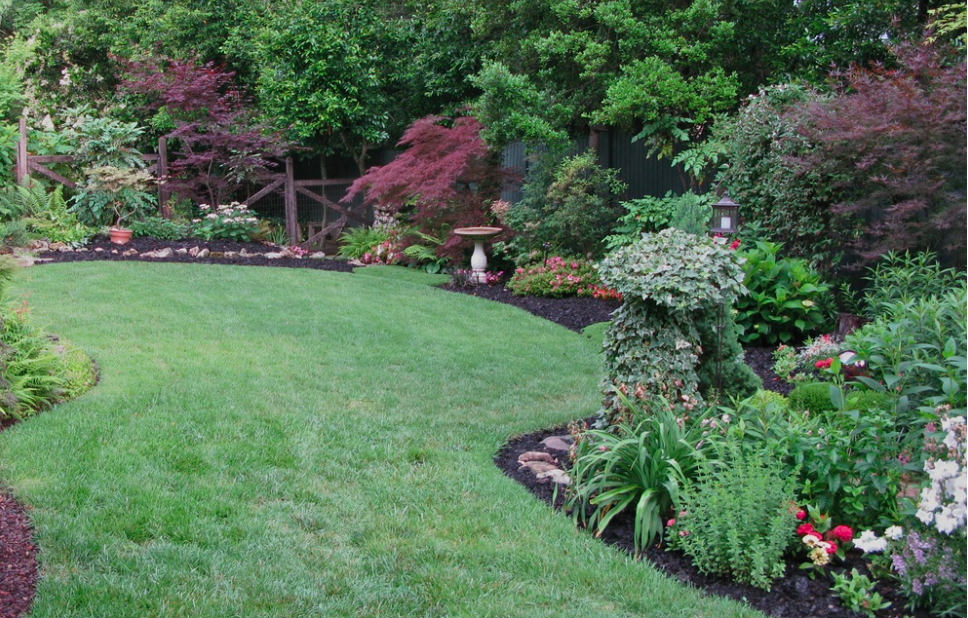Tired of being a slave to lawn chores? Join others in a growing trend to replace lawns with landscapes that are easier and cheaper to maintain and better for the environment. When you replace turf grass with native groundcovers, trees, shrubs, perennial flower beds, and other diverse plantings, you will not only save time and money but also contribute to a healthier environment for the people and wildlife of New Jersey.
Mowing, watering, fertilizing, and other lawn care tasks require both time and money. Lawns also have environmental costs. Synthetic chemicals used to fertilize and control pests are a source of pollution, and wildlife habitat is lost when turf grass replaces native vegetation.
The Interactive Yard: Learn How to Reduce Your Lawn Size
Small areas of healthy lawn do have a place in the home landscape. Turf grass tolerates regular foot traffic, making it well-suited for outdoor play and recreational spaces. However, when you factor in the high maintenance costs, it doesn’t make sense to maintain large unused areas of lawn.

In your Jersey-Friendly Yard, think about how you use your lawn and how you can replace unused turf grass with less costly, more environmentally friendly native vegetation. A good place to start is along property edges, sidewalks, and driveways.
Besides diversifying your landscape, replacing lawn with shrub borders, perennial flower beds, rain gardens, and other mixed native plantings will:
- Save the time and money you would have spent mowing, fertilizing, watering, and controlling the weeds and pests on your lawn;
- Reduce the quantity of polluting lawn chemicals (fertilizers, herbicides, and pesticides) that rain water runoff from lawns washes into local rivers, lakes, and bays;
- Decrease air pollution from gas-powered lawn mowers;
- Provide more habitat for birds, pollinators, and other local wildlife; and
- Add beauty and seasonal interest to your yard.

Did you know?
There are about 40 million acres of lawn in the United States – turf grass has become our largest “crop.”
Every year Americans:
- Use about 580 million gallons of gasoline to mow lawns;
- Spend over $5 billion on fossil fuel-derived lawn fertilizers;
- Use about 67 million pounds of pesticides on lawns;
- Use more than 2.5 trillion gallons of water to irrigate lawns; and
- Spend an average of 40 hours, or one work week, per year mowing the lawn.
Keep It Low-Maintenance on Remaining Lawn Areas
Reduce the impacts of a lawn on the environment and on your bank account by choosing the right turf grass varieties and by following Rutgers guidelines for proper lawn care and maintenance. Here are a few general tips:
- Get a soil test. The soil test results will tell you what type, if any, fertilizer you need and how much to apply. Learn more about importance of soil health.
- Use slow-release fertilizers when amendments are needed and apply them responsibly. Learn how to fertilize responsibly.
- Mow high. Keeping turf at the proper height shades grass roots and reduces evaporation of soil moisture. Rutgers recommends maintaining a height of 2.5 to 3 inches for most cool season grasses.
- Use a mulching mower. Grass clippings can provide as much as one-half of the nitrogen required for a healthy lawn.
- Seed with low-maintenance grass species. Tall fescues and fine fescues need less nitrogen and water than Kentucky bluegrass and perennial ryegrass species.
- Water only where and when needed. Learn how to water wisely.
- Aerate. Opening air channels in the soil improves the natural movement of water and air into the ground. The best time of the year to aerate lawns in New Jersey is in late summer/early fall, when cool season grasses are actively growing and the soil is only slightly moist.
Additional Resources for Reducing Lawn Size
University of Maryland Extension: Lawn Alternatives
Duke Farms: Stewardship at Home – Perennial Meadow
Rutgers University Resources for Low-Maintenance Lawns
Your Lawn and Its Care
How to Protect Water Quality and Have a Beautiful Lawn
Conserving Water on Home Lawns and Landscapes in New Jersey
Seeding Your Lawn
List of Rutgers NJAES Lawn Fact Sheets and Bulletins
